Chapter: Psychiatric Mental Health Nursing : Neurobiologic Theories and Psychopharmacology
The Nervous System and How It Works
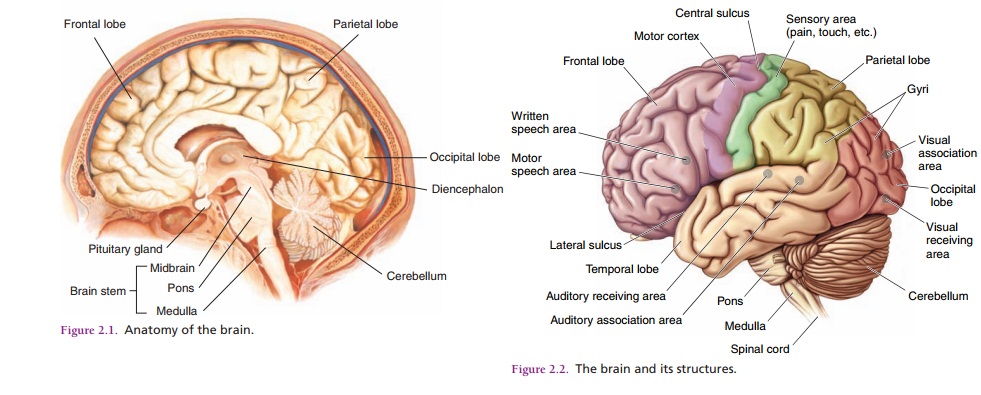
BRAIN IMAGING TECHNIQUES
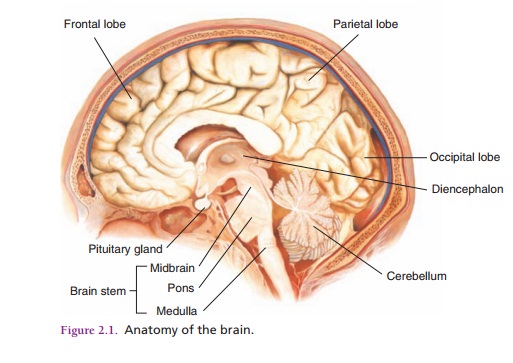
Central Nervous System
The CNS is composed of the brain, the spinal cord, and associated nerves that control voluntary acts. Structurally, the brain consists of the cerebrum, cerebellum, brain stem, and limbic system. Figures 2.1 and 2.2 show the locations of brain structures.![]()
![]()
Cerebrum
The cerebrum is divided into two hemispheres; all lobes and structures are found in both halves except for the pineal body, or gland, which is located between the hemi-spheres. The pineal body is an endocrine gland that influences the activities of the pituitary gland, islets of Langerhans, parathyroids, adrenals, and gonads. The cor-pus callosum is a pathway connecting the two hemispheres and coordinating their functions. The left hemisphere controls the right side of the body and is the center for logical reasoning and analytic functions such as reading, writing, and mathematical tasks. The right hemisphere controls the left side of the body and is the center for cre-ative thinking, intuition, and artistic abilities.
The cerebral hemispheres are divided into four lobes: frontal, parietal, temporal, and occipital. Some functions of the lobes are distinct; others are integrated. The frontal lobes control the organization of thought, body move-ment, memories, emotions, and moral behavior. The inte-gration of all this information regulates arousal, focuses attention, and enables problem-solving and decision mak-ing. Abnormalities in the frontal lobes are associated with schizophrenia, attention deficit hyperactivity disorder (ADHD), and dementia. The parietal lobes interpret sensa-tions of taste and touch and assist in spatial orientation. The temporal lobes are centers for the senses of smell and hearing and for memory and emotional expression. The occipital lobes assist in coordinating language generation and visual interpretation, such as depth perception.
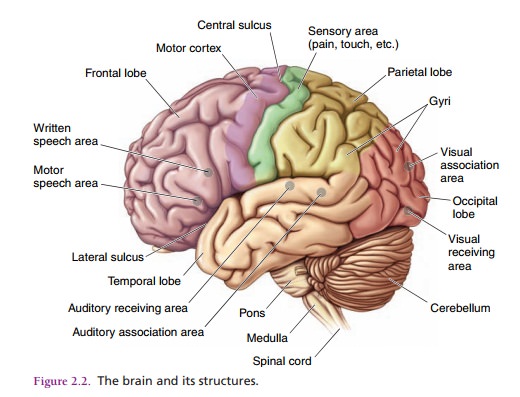
Cerebellum
The cerebellum is located below the cerebrum and is the cen-ter for coordination of movements and postural adjustments. It receives and integrates information from all areas of the body, such as the muscles, joints, organs, and other compo-nents of the CNS. Research has shown that inhibited transmission of dopamine, a neurotransmitter, in this area is associated with the lack of smooth coordinated movements in diseases such as Parkinson’s disease and dementia.
Brain Stem
The brain stem includes the midbrain, pons, and medulla oblongata and the nuclei for cranial nerves III through XII. The medulla, located at the top of the spinal cord, contains vital centers for respiration and cardiovascular functions. Above the medulla and in front of the cerebrum, the pons bridges the gap both structurally and functionally, serving as a primary motor pathway. The midbrain connects the pons and cerebellum with the cerebrum. It measures only 0.8 inches (2 cm) long and includes most of the reticular activating system and the extrapyramidal system. The reticular activating system influences motor activity, sleep, consciousness, and awareness. The extrapyramidal system relays information about movement and coordination from the brain to the spinal nerves. The locus ceruleus, a small group of norepinephrine-producing neurons in the brain stem, is associated with stress, anxiety, and impul-sive behavior.
Limbic System
The limbic system is an area of the brain located above the brain stem that includes the thalamus, hypothalamus, hip-pocampus, and amygdala (although some sources differ regarding the structures this system includes). The thala-mus regulates activity, sensation, and emotion. The hypo-thalamus is involved in temperature regulation, appetitecontrol, endocrine function, sexual drive, and impulsive behavior associated with feelings of anger, rage, or excite-ment. The hippocampus and amygdala are involved in emotional arousal and memory. Disturbances in the limbic system have been implicated in a variety of mental ill-nesses, such as the memory loss that accompanies demen-tia and the poorly controlled emotions and impulses seen with psychotic or manic behavior.
Neurotransmitters
Approximately 100 billion brain cells form groups of neu-rons, or nerve cells, that are arranged in networks. These neurons communicate information with one another by sending electrochemical messages from neuron to neuron, a process calledneurotransmission. These electrochemical messages pass from the dendrites (projections from the cell body), through the soma or cell body, down the axon (long extended structures), and across the synapses (gaps between cells) to the dendrites of the next neuron. In the nervous system, the electrochemical messages cross the synapses between neural cells by way of special chemical messengers called neurotransmitters.
Neurotransmitters are the chemical substances manu-factured in the neuron that aid in the transmission of infor-mation throughout the body. They either excite or stimulate an action in the cells (excitatory) or inhibit or stop an action (inhibitory). These neurotransmitters fit into specific recep-tor cells embedded in the membrane of the dendrite, just like a certain key shape fits into a lock. After neurotransmit-ters are released into the synapse and relay the message to the receptor cells, they are either transported back from the synapse to the axon to be stored for later use (reuptake) or metabolized and inactivated by enzymes, primarily mono-amine oxidase (MAO) (Figure 2.3).
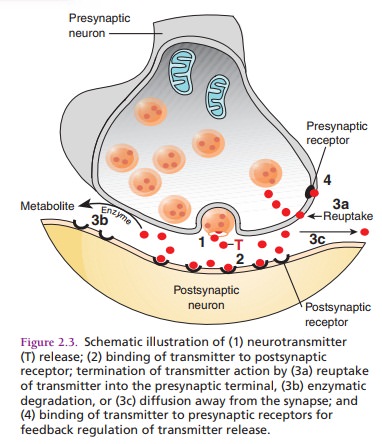
These neurotransmitters are necessary in just the right proportions to relay messages across the synapses. Studies are beginning to show differences in the amount of some neurotransmitters available in the brains of people with certain mental disorders compared with people who have no signs of mental illness (Figure 2.4).
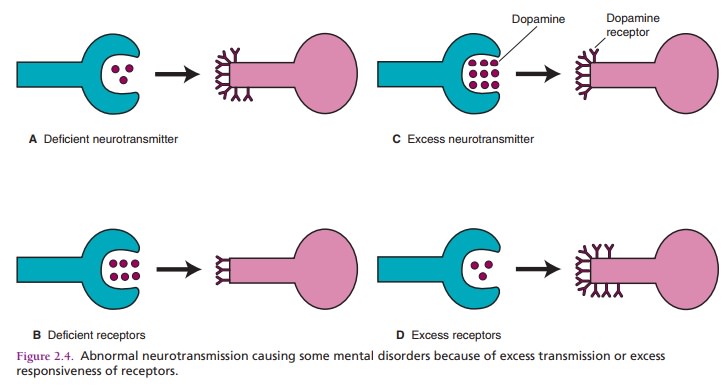
Major neurotransmitters have been found to play a role in psychiatric illnesses as well as in the actions and side effects of psychotropic drugs. Table 2.1 lists the major neu-rotransmitters and their actions and effects. Dopamine and serotonin have received the most attention in terms of the study and treatment of psychiatric disorders (Tecott & Smart, 2005). The following sections discuss the major neurotransmitters associated with mental disorders.

Dopamine
Dopamine, a neurotransmitter located primarily in the brain stem, has been found to be involved in the control of complex movements, motivation, cognition, and regula-tion of emotional responses. It is generally excitatory and is synthesized from tyrosine, a dietary amino acid. Dop-amine is implicated in schizophrenia and other psychoses as well as in movement disorders such as Parkinson’s dis-ease. Antipsychotic medications work by blocking dop-amine receptors and reducing dopamine activity.
Norepinephrine and Epinephrine
Norepinephrine, the most prevalent neurotransmitter in the nervous system, is located primarily in the brain stem and plays a role in changes in attention, learning and memory, sleep and wakefulness, and mood regulation. Norepinephrine and its derivative,epinephrine, are also known as noradrenaline and adrenaline, respectively. Excess norepinephrine has been implicated in several anx-iety disorders; deficits may contribute to memory loss, social withdrawal, and depression. Some antidepressants block the reuptake of norepinephrine, whereas others inhibit MAO from metabolizing it. Epinephrine has lim-ited distribution in the brain but controls the fight-or-flight response in the peripheral nervous system.
Serotonin
Serotonin, a neurotransmitter found only in the brain, is derived from tryptophan, a dietary amino acid. The function of serotonin is mostly inhibitory, and it is involved in the control of food intake, sleep and wakefulness, temperature regulation, pain control, sexual behavior, and regulation of emotions. Serotonin plays an important role in anxiety and mood disorders and schizophrenia. It has been found to con-tribute to the delusions, hallucinations, and withdrawn behavior seen in schizophrenia. Some antidepressants block serotonin reuptake, thus leaving it available longer in the synapse, which results in improved mood.
Histamine
The role of histamine in mental illness is under investiga-tion. It is involved in peripheral allergic responses, control of gastric secretions, cardiac stimulation, and alertness. Some psychotropic drugs block histamine, resulting in weight gain, sedation, and hypotension.
Acetylcholine
Acetylcholine is a neurotransmitter found in the brain, spinal cord, and peripheral nervous system, particularly at the neuromuscular junction of skeletal muscle. It can be excitatory or inhibitory. It is synthesized from dietary cho-line found in red meat and vegetables and has been found to affect the sleep–wake cycle and to signal muscles to become active. Studies have shown that people with Alzheimer’s disease have decreased acetylcholine-secreting neurons, and people with myasthenia gravis (a musculardisorder in which impulses fail to pass the myoneural junction, which causes muscle weakness) have reduced acetylcholine receptors.
Glutamate
Glutamate is an excitatory amino acid that at high levels can have major neurotoxic effects. It has been implicated in the brain damage caused by stroke, hypoglycemia, sustained hypoxia or ischemia, and some degenerative dis-eases such as Huntington’s or Alzheimer’s.
Gamma-Aminobutyric Acid
Gamma-aminobutyric acid (Îł-aminobutyric acid, or GABA), an amino acid, is the major inhibitory neurotrans-mitter in the brain and has been found to modulate other neurotransmitter systems rather than to provide a direct stimulus (Plata-Salaman, Shank, & Smith-Swintosky, 2005). Drugs that increase GABA function, such as benzo-diazepines, are used to treat anxiety and to induce sleep.
Related Topics